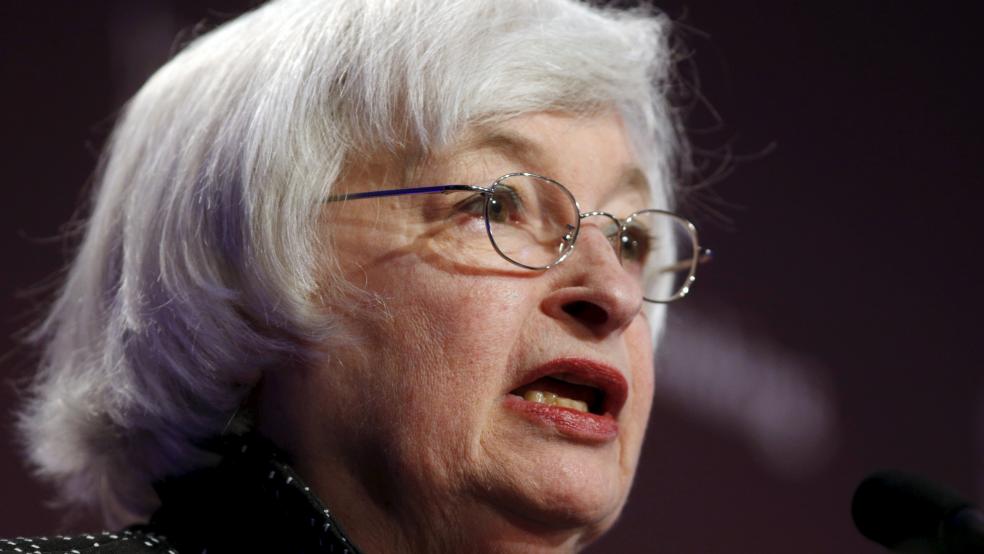The Federal Reserve has been the GOP’s punching bag lately.
During their debate this week, Republican presidential candidates alternately blamed the Fed for income inequality, a weak dollar, a strong dollar and a lack of Social Security increases. Last week, Rep. Kevin Brady (R-TX) said he wanted to examine the central bank’s monetary policy and reduce its legislated powers.
But the Federal Reserve’s expansive powers and independence from lawmakers is by design, thanks to Congress, which created it.
“The U.S., like most other capitalistic democracies, realized if you let politicians control and establish interest rates, you have more inflation,” says David Wessel, director of the Hutchins Center on Fiscal and Monetary Policy at the Brookings Institution. “So Congress decided to assign this chore to technocrats who are supposed to be insulated from the pulling and tugging of politics and can do things that may be unpopular but necessary.”
Related: 10 Ways the Fed’s Looming Rate Hike Touches You
Wessel noted that the Federal Reserve also regulates the banking system and promotes financial stability in addition to influencing interest rates.
Here’s the nitty gritty on what the Fed is and all that it does:
What is the Federal Reserve?
Founded in 1913 by an act of Congress, the Federal Reserve System — also referred to as the U.S. central bank — originally was created to prevent bank panics. Historically, people would withdraw their funds in droves in times of uncertainty and, like dominoes, collapse the entire banking system. The system has since evolved to support a stable banking system and, more generally, a healthy economy.
By design, the Fed is an independent agency that can conduct its duties without political pressure.
How is the Federal Reserve structured?
The Federal Reserve System is divided into three components: the Board of Governors, the 12 regional Reserve Banks, and the Federal Open Market Committee, or FOMC.
Who owns the Federal Reserve?
The Board of Governors is a federal government agency. But the 12 regional Reserve Banks are not part of the federal government. Instead, they have been established like private corporations where member banks hold their stock, which can’t be sold or pledged as loan collateral.
What is the Fed’s mission?
The Fed has three main responsibilities: carrying out monetary policy with its dual mandate of price stability and maximum employment in mind; supervising and regulating banks; and providing financial services to banks.
Related: Looks Like Congress Can’t Stand the Idea of an Independent Federal Reserve
Who are the Board of Governors?
Seven members appointed by the president and confirmed by Senate make up the Board of Governors. The members serve staggered 14-year terms to avoid political stacking by any one president. The duty of the board is to guide the Federal Reserve’s policy action.
The chair and vice chair of the Board of Governors also are appointed by the president, but serve only four-year terms. The chair, currently Janet Yellen, reports to Congress twice a year on the central bank’s monetary policy objectives; testifies before Congress on various issues; and meets with the Treasury Secretary periodically.
What does the Board of Governors do?
The seven-member board directs the Federal Reserve’s policy actions to guarantee financially healthy banks and a strong U.S. economy. It does this by conducting monetary policymaking, examining prevailing economic trends and issues and forecasting the future economic direction. It also supervises member banks and bank holding companies and oversees the regional Reserve Banks.
What are the regional Reserve Banks?
In general, the regional Reserve Banks carry out the central bank’s regulatory policies and enforce banking and consumer protection laws legislated by Congress at the regional level.
Related: How the Fed Keeps Sowing Uncertainty and Confusion
Each bank’s board of directors is made up of nine members, six of which are appointed by its member banks and three of which are appointed by the Board of Governors. The board chairman and deputy chairman are selected by the Board of Governors from its three appointees.
What do the Reserve Banks do?
The Reserve Banks provide banking services to commercial banks such as distributing currency, lending money and processing electronic payments. The banks also maintain the accounts for the U.S. Treasury, process government checks, handle auctions of government securities and put currency into circulation. The banks research the regional, national and international economies; typical projects include collecting loan and deposit data to analyze regional and national bank performance, credit demand and other banking issues. This information is culled into what is called the Beige Book that is published before the meetings of the FOMC.
What is the FOMC?
The FOMC, or Federal Open Market Committee, is the group that sets monetary policy. It is made up of the seven-member Board of Governors, the president of the Federal Reserve Bank of New York and four Reserve Bank presidents. The bank presidents serve one-year terms and rotate with the remaining bank presidents.
The committee meets eight times a year to determine which policy actions would best encourage sustainable economic growth and support the Federal Reserve’s dual mandate. Typically, this means it sets a target for the federal funds rate, the rate banks charge each other for overnight loans, which affects interest rates on consumer and business loans.
How are the FOMC’s policy actions carried out?
The FOMC gives its fed funds rate target to the New York Fed’s trading desk, which uses open market operations to carry it out. If the FOMC wants to lower the rate, the desk will buy government securities on the open market. To increase the rate, the desk will sell those securities.
What are the Federal Reserve’s monetary policy tools?
The Federal Reserve has three tools at its disposal that manipulate the amount of funds in the banking system to meet its monetary policy goals: the discount rate, the reserve requirements and open market operations.
The discount rate is the interest rate that commercial banks are charged for short-term loans from the Reserve Banks. Changes to discount rates are made by the Reserve Banks and the Board of Governors. The reserve requirements are the amount of deposits that banks must keep on hold in cash. Only the Board of Governors can alter the reserve requirement and rarely does so. The open market operations is the buying and selling of government securities as directed by the FOMC and its target for the federal funds rate, the rate that everyone is watching next month.





